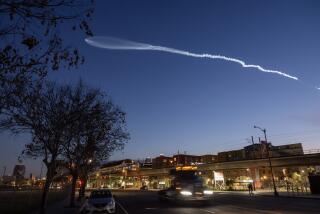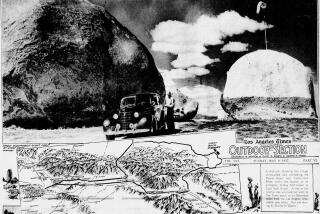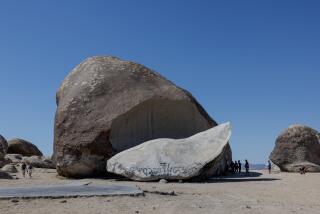Daily Lives of Residents Near Missile Range Tested in Unusual Ways
- Share via
ENGLE, N.M. — On the morning after their wedding on the family ranch back in 1983, when any newlywed couple might be expected to dawdle, Russell and Hazel Cain wrenched themselves from sleep early. Along with their wedding guests, they were forced to drive into this thinly peopled desert community, park in the church lot and wait--until the regularly scheduled missile test over their house and land was completed.
“We had lots of company, lots of out-of-town people,” said Hazel Cain, 48. “They got a true New Mexico experience.”
For the Cains and about 80 families who live around Engle on this expanse of desert in southern New Mexico, having to leave home once or twice a month while a missile goes off at nearby White Sands Missile Range is part of life. No one here seems to dwell much on the obvious reason for the evacuation: the slim chance that an errant missile could touch down on one’s house, or one’s head.
In this vast state, where America’s deepest military secrets are developed and put to the test, residents take the occasional disruption for granted.
But people who live here are sometimes conflicted about the presence and influence of the federal government. On one hand, they resent the intrusion into environmental matters and grazing rights. On the other, they recognize how utterly dependent the state’s economy is on the machinations of Washington politics and the largess of the federal coffers.
“We have no logging, we have no oil and gas drilling, and the cattle industry is dying--that makes us entirely dependent on defense,” said Jim Catron, the county attorney for Catron, Sierra and Socorro counties who has successfully sued the federal government on an environmental issue. “What are we going to do when [Senate Budget Chairman] Pete Domenici [R-N.M.] dies or gets tired of the Beltway and comes home? May he live as long as Strom Thurmond, or this whole state will be a ghost town.”
It is probably hard for an outsider to imagine the lonesome beauty of this high desert country about 150 miles south of Albuquerque. Mesquite and yuccas dot the pastures of the desert floor, the rough young mountains rising in layers of gray and brown. At night, the stars give off a hard sparkle, without the reflection of city lights to dilute them, and, as the eye adjusts, a milky shimmer seems to swirl through the sky. Jack rabbits, too plentiful and ravenous for the ranchers’ favor, dart into the oncoming headlights of cars, zigzagging, not always successfully, across the otherwise empty road.
This is the place that became known as Jornada del Muerto, or Dead Man’s Day, for the many Spanish conquistadors in the 1500s who failed to make it across the rough terrain. Four centuries later, it witnessed the dawn of the nuclear age. The world’s first atomic bomb was detonated here in a test on July 16, 1945. A few weeks later, two more bombs were dropped on the Japanese cities of Hiroshima and Nagasaki.
People who live within riding distance of such a momentous spot tend to look at life a little differently from Americans who live in more mundane settings. Things that may seem fantastical to an outsider are just not that big a deal. Children, for instance, grow up hearing legends about that first mushroom cloud, about the light so intense that a blind woman supposedly saw it flash. In the 1950s, a few people sneaked onto the bomb site and grabbed bits of the strange green glass that was formed when the test bomb melted the sand and grass. Some wore necklaces made of the substance; small boys coveted the rocks.
In this part of the country, missile test reports on the morning radio are as common as surfing reports in Los Angeles. As often as two or three times a week, a strip of U.S. 70 between Las Cruces and Alamogordo, ranging from seven miles to 40 miles long, is shut down for certain periods to allow missiles to zoom across the highway. Woe be to the unsuspecting tourist who thinks he is going to glide through on a sizzling day that also happens to be a testing day.
And here, getting “a green card” has nothing to do with immigration matters. It is a signal to residents like the Cains that the “maybe” test notification they received earlier in the month is a good bet to happen; it means the grown-ups have no choice but to abandon the cattle and the chores and take a holiday in town.
“I have to say it’s more fun now than it was back when I was little,” said Russell Cain, 46, who grew up with the bomb test interruptions. “Now it’s like a play day for a grown-up. It’s a good golf day. I mean, there’s just nothing else I can do.”
The evacuations play no favorites. Even, presumably, media mogul Ted Turner, who has recently become one of the largest landowners in New Mexico, must leave his ranch near the western boundary of White Sands when the green cards are handed out, although residents say he is seldom around enough to experience that rite of passage.
White Sands--the largest military installation in the country, covering 3,200 square miles, an area equivalent to Rhode Island and Delaware plus the District of Columbia--is, not surprisingly, also the largest employer in southern New Mexico, where towns and job opportunities are scarce. About 6,700 people worked at the base in fiscal year 1997; during the Persian Gulf War in the 1990s, the number soared to 9,000.
The complex has been the site of tests involving weapons from Nike, Viking and Lance missiles to multiple rocket-launch systems to the Big One. Between 1945 and fiscal 1996, 41,593 missiles were fired here, according to the base’s public affairs office. In 1996 alone, not a particularly active year, 368 missiles were fired, and 32 other tests were performed involving bomb drops, explosives, guns and balloons.
Since 1960, the facility has operated what base officials refer to as “call-up areas” along the range’s western boundary and along a 40-by-40-mile square to the north. Under contracts with area ranchers, White Sands is allowed to evacuate residents for a 12-hour period, often beginning at a gruesome 5 a.m., thus doubling the available area for testing a long-range missile.
For their government-imposed day in town, Hazel and Russell Cain have to drive from their 64,000-acre ranch to Engle, or sometimes about 23 miles north to the little town of Truth or Consequences. For their trouble, they receive $60 apiece for food and expenses.
Russell’s mother, Grace, who has lived on the ranch for 31 years, has long since grown accustomed to the interruptions. Back when her three children were school age, the family kept a house in town for testing days.
“Years ago, in the ‘60s, when they were testing the Athena missile, we might have to evacuate as many as four to six times a month,” she recalled. “I guess it’s just something we haven’t thought much about over the years. It gets to be a part of your life. . . . “
That is the general attitude among residents: It’s only a little trouble, not a bad thing--even when they do make the occasional odd discovery on their land. Recently, for instance, Russell Cain happened upon a shaft of twisted pea-green metal, about 8 feet long and 4 feet wide, pitted with holes, surprisingly lightweight, and flung down in one of the most remote parts of his immense ranch: more White Sands litter.
More to Read
Sign up for Essential California
The most important California stories and recommendations in your inbox every morning.
You may occasionally receive promotional content from the Los Angeles Times.










